Last Updated on March 14, 2025 by Owen McGab Enaohwo
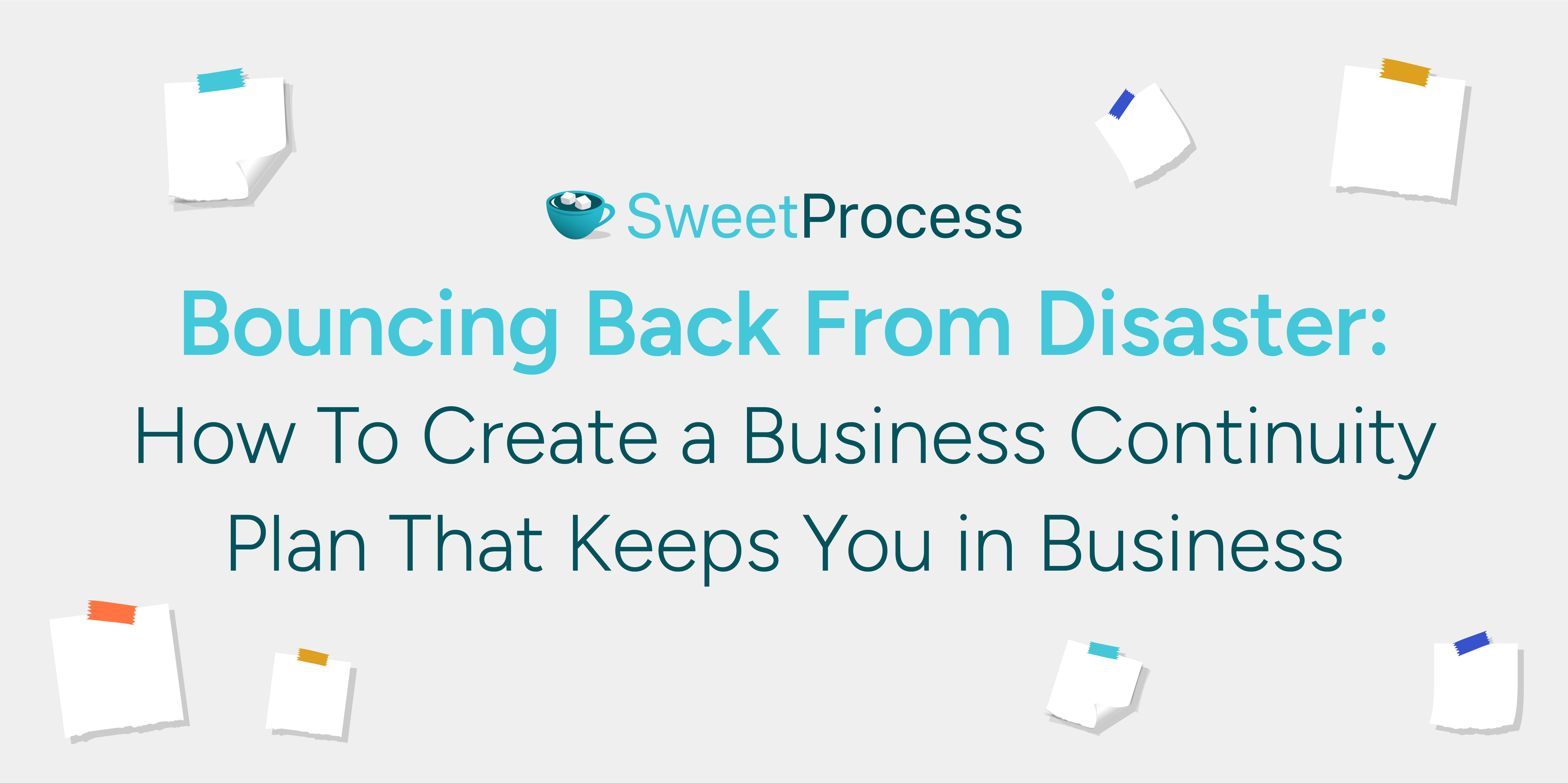
COVID-19 rocked the world down to its very foundation. Apart from the exceptions that cashed out from the chaos–like gold traders and course creators–most businesses suffered. The hardship wasn’t for nothing, however. It taught many entrepreneurs the importance of preparedness and resilience.
Business growth doesn’t trend in a straight line. Where’s the fun in that? There will invariably be setbacks, some bigger than others. To survive, it is crucial to be prepared for adversity.
In this article, we’ll explore what a business continuity plan is, what elements make up a business continuity plan, and how you can create a business continuity plan that keeps your business running even in the face of brutal setbacks.
SweetProcess can help you implement your business continuity plan. To learn more, take SweetProcess for a spin. It’s free for 14 days.
Table of Contents
What Is a Business Continuity Plan?
Benefits of a Business Continuity Plan
Business Continuity Plan vs. Disaster Recovery: How Are They Different?
How To Create an Effective Business Continuity Plan
Components of a BCP: What Should a Business Continuity Plan Include?
How SweetProcess Can Help You Implement a Business Continuity Plan
How a Dental Clinic Used SweetProcess to Keep Operating Safely After COVID-19
It’s Not All Fun: Challenges of BCP Implementation
Validating Your Business Process Plans: Types of BCP Testing
Business Continuity Plan Application: Real-World Impact
SweetProcess, Your Partner in Agility
What Is a Business Continuity Plan?
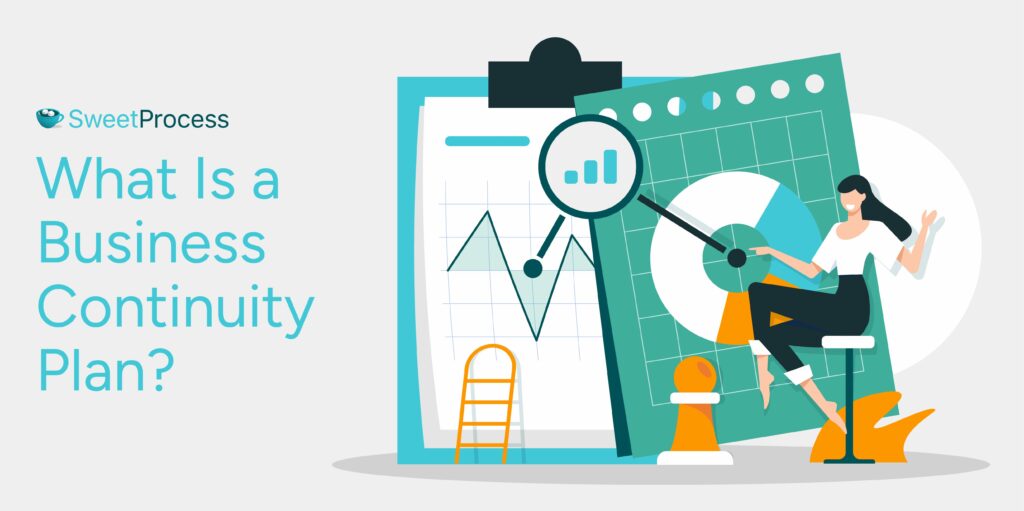
A Business Continuity Plan (BCP) is a preemptive protocol that keeps a business running during and after a disruptive event. Disruptions can take many forms, from a supply chain disturbance to a natural disaster, but typically, they threaten business operations.
The following are examples of events that could cause unplanned disruption in a business’s operations:
- Loss of key premises
- Loss of key staff
- Loss of IT/data
- Loss of telecommunications
- Loss of hard data/paper records
- Loss of utilities (electricity, water, gas)
- Loss of a key partner or supplier
- Disruption due to industrial action
- Disruption due to severe weather
The goal of a BCP isn’t simply to keep the lights on and maintain some productivity. Rather, the goal is to maintain critical business functions during a disruption, ensuring that products and services can be delivered at an acceptable quality and in an acceptable time frame.
Naturally, the scope of BCPs will vary with business size, industry, and function. Essentially, though, their structure and goals remain the same: business resilience.
BCPs don’t exist in a vacuum. They are created and executed by real people, so your team must be involved in creating these assets. It is also helpful to bake your BCP strategy into your company culture. Creating a culture of preparedness means everyone on your team understands the goal of your business continuity strategy. They know their roles within that strategy and understand what the company will lose if they do not execute their designated roles and responsibilities.
Benefits of a Business Continuity Plan

Most businesses never recover from disasters. Even in the case of disruptions, they incur avoidable losses. That’s a no-brainer because businesses typically operate without a safety net. They are only concerned with “opening shop” the next day and continuing to generate turnover. But this is a big mistake that far too many businesses make.
According to FEMA (Federal Emergency Management Agency), about 43% of small businesses never reopen after a disaster, and another 29% go bust within two years of the disaster. These are grim numbers.
However, they conclude that businesses must stay prepared to survive. Perhaps the biggest benefit of BCPs is resilience. However, there are many more benefits of correctly creating and implementing a continuity plan in your business. We’ll discuss them below.
Resilience
What is business resilience, even? It is about adaptability. Simply put, a business can rebound from disaster or disruptions and fulfill business objectives despite adverse conditions.
BCPs are solely intended to keep a business running during and after setbacks. Simply implementing a BCP strategy can make a business more prepared and, thus, more resilient.
Resilience isn’t just a binary concept. It exists on a spectrum. So, it’s not just a question of whether your business is resilient. It’s also a question of how resilient your business is.
Can your business manage power outages like it could handle a fire outbreak or disaster? The extent to which your business continuity plan is comprehensive will determine this.
Employee Confidence
Preparedness inspires confidence in your team. Because they have a clear plan, tools, and training to follow through with it, they know the plan, have tested it multiple times, and know it will work.
They also know you’ve got them because if you’re prepared for adversity, you’ll stay in business and secure their jobs. This may create a positive organizational culture where your team provides massive value in return for the security you give them.
This confidence also translates into customer-facing communication. When your team is backed by a solid plan with positive outcomes in view, they talk to your customers confidently. They can be empathetic and honest.
Positive Branding
Your customers are more astute than you may imagine. They can pick up on how organized you are. Dead giveaways of chaos could be ambiguous, inconsistent replies from your customer success team during service downtime. In contrast, honest, empathetic, straightforward replies communicate your team’s ability to deliver excellent service.
Besides trickling down confidence from your team to your customers, agility and responsiveness evoke feelings of awe and security in your customers. Do you mean your logistics team is still functional two hours after a fire broke out in your factory? Impossible!
Continuing to provide services and distribute products even in the face of disaster sends a powerful message to the customer that they are central to your business. This creates massive brand equity that will continue to pay off.
Reduced Financial Loss
Disruptions and downtimes can result in spectacular losses. Big businesses like brokerage firms can lose up to $6.48 million per hour. This is a mind-boggling loss, especially considering that the industry average is only $5,600 per minute or $336,000 per hour.
Although the consequences aren’t as harsh for smaller businesses, there are still many ways for small or medium-sized businesses to incur losses. Poorly handled downtime can cause customers to lose faith in a business and try to find solutions everywhere.
Other costs that may result from downtime also exist. Sometimes, missed supply deadlines attract extra fees from vendors, as keeping supplies in stock could cost them money. Floating in this soupy mess of loss, you could also encounter fines for non-compliance or legal fees from disgruntled customers.
Insurance Benefits
It’s no news that insurance companies study risk for a living. Risk, its nature, and its evaluation are the insurance business. So, insurance companies can see the pitfalls you may be oblivious to.
If your business is insured, you may enjoy cheaper insurance because the insurance company sees that you have removed some risk from your business. This typically leads to financial savings over time.
Stakeholder Confidence
Some investors prefer low-risk investments, meaning they prioritize investments that will bear fruit for the foreseeable future. For this type of investor, even the risk-loving type, a business with a thorough continuity plan makes an attractive investment.
If you ever plan to sell your business, these risk management systems will make it easier to sell for a nice, juicy profit.
Regulatory Compliance
Some industries have to enforce preparedness. If your business is in one of those industries, you must create a workable continuity plan to operate legally and within regulatory requirements.
Regulatory compliance is essential in oil and gas, food, and pharmaceuticals. By creating a plan with your team and integrating it into your team culture, you can operate without the risk of significant fines or legal issues.
Decisive Crisis Management
A plan makes decision-making easy during a crisis. If you’ve done the work to assign roles and responsibilities, everyone on your team knows what is expected of them and has the tools and training to execute what they’ve learned.
When the unexpected happens (as it is wont to do), leaders can still make key decisions. A business continuity plan provides a decision-making framework because it outlines the overarching priorities and objectives.
Competitive Advantage
Implementing a BCP plan can give you an immense competitive advantage. While your competitors scramble to solve problems they didn’t prepare for, you are up and running quickly.
What happens when a customer’s preferred vendor or service provider is offline? They find alternatives. And if your service or product meets and maybe exceeds their expectations, you’ve just acquired a new customer without much work.
The flip side is that if you’re not prepared, you could lose your hard-earned customers if you’re offline for too long. Your marketing team won’t be too pleased when you come back online.
Unique Business Insight
As we’ll see later, one step in creating a BCP is conducting a business impact analysis. However, a business impact analysis also provides an opportunity to observe the condition of other aspects of your business.
A business impact analysis can provide insights about your team’s strengths and weaknesses, including details about their personalities, skills, and weaknesses. You also get insights into your technologies and platforms and how they connect, whether any are redundant, and how you can reconcile that redundancy.
Process Improvement
Another area that benefits from the insights you get from a business impact analysis is your process assets. Dissecting your workflows will reveal process inefficiencies, which you can then improve.
Once you spot gaps in your workflows, you can fill them and make your processes more efficient.
Team Safety
In businesses where your team operates from a physical location and uses machinery to execute business operations, you must have continuity plans in place to protect the lives and safety of your team members.
Training that focuses on evacuation and accident handling is crucial in crises. Without safety protocols, the loss of life can be significant.
Business Continuity Plan vs. Disaster Recovery: How Are They Different?

Business continuity and disaster recovery plans are similar in their nature and objectives, but the similarities end there. The real difference is in their scope.
BCPs and DRPs are risk management strategies that aim to restore business functionality in a disaster. They are also preemptive.
However, BCPs aim to restore the functionality of core business operations so that customers can continue to be satisfied with the delivery of products and services.
DRPs, on the other hand, are focused on IT recovery. The DRP rabbit hole opens up into RTO (recovery time objective) and RPO (recovery point objective), which are outside the scope of this article.
Since most businesses rely on crucial IT infrastructure, they may benefit from a DRP strategy as well as a BCP strategy. Luckily, since there’s so much overlap between both concepts, planning, creating, and implementing both strategies doesn’t require much extra resource.
How To Create an Effective Business Continuity Plan

Now that you’re convinced about why you need a business continuity plan, let’s look at how you should actually create one.
Analysis
As with most plans and systems, the first step is to get a bird’s eye view of the situation so that you can plan accordingly. If a business continues to plan, two analyses must be conducted to understand its needs.
A risk analysis and a business impact analysis uncover a BCP’s scope. A risk analysis projects potential disruptions or disasters a business could encounter and explores some scenarios or situations in which a business would need a continuity plan.
On the other hand, a business impact analysis goes deeper into the impact of the risks already uncovered. Both techniques give management and C-level executives insights on where to begin the business continuity planning process.
Strategy/Design
Once the plan’s scope has been established and potential threats and risks evaluated, the next step is to design a strategy that suits the business based on its resources.
In this stage, it’s important to consider the overarching vision and mission to create a strategy that serves the greater good.
Validate/Test
The rough sketch or plan isn’t quite ready for implementation. You should validate your plan first. Involve your team members and try to pencil in the sketch you already have.
As we’ll see later, there are a few techniques and strategies for validating and testing your BCP.
Optimize
Once you have validated your plan and have performance data, optimize the plan based on the big picture you established from the risk assessments.
Because there are no concrete metrics to measure performance, use feedback from your team to determine what to improve in the plan and get suggestions on what to change.
Improve
Companies change, their leadership changes, and people come and go. It is important to create a business continuity management systems that keep improving your BCP.
Have a six-month or one-year plan to regularly revise and update your business continuity plan as your needs change.
Components of a BCP: What Should a Business Continuity Plan Include?
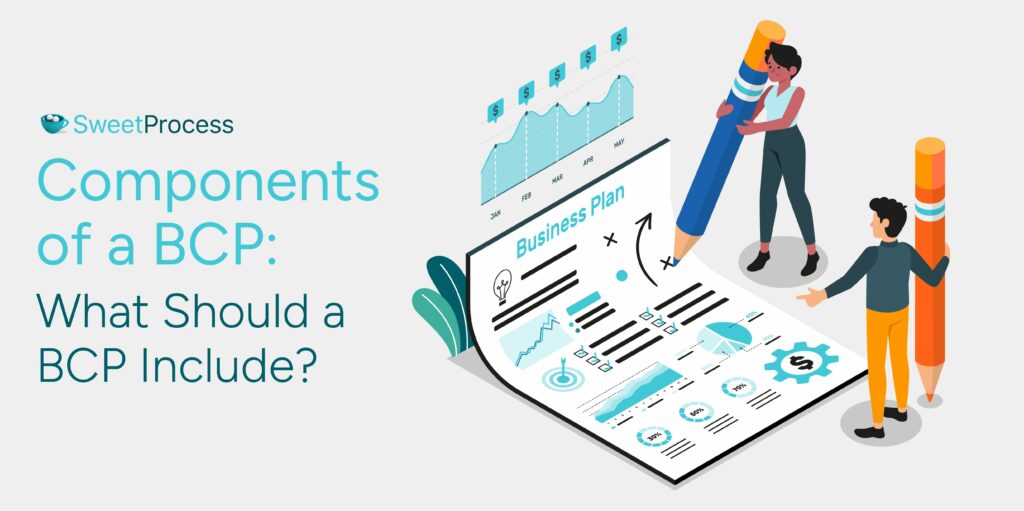
The components of a business continuity plan will vary on a case-by-case basis. However, the following elements can make your business continuity plan easier to use.
Scope and Objectives
This section typically appears in the first few pages of a BCP document. The purpose of the scope is to provide context about the areas a BCP covers, from teams to critical business operations. Objectives take it a step further and provide context as to the specific goals for that specific plan.
This is especially useful for big companies with many big departments operating together. The bigger the business, the more moving parts there are, thus the more complex the business continuity planning has to be. Where small businesses may simply have just one document that caters to their needs, big businesses may need more documents, each with its own scope and objectives section.
Roles and Responsibilities
BCPs need people to execute. So, your BCP needs to show team members what is required of them and who specifically will execute which elements of the plan.
This is where a roles and responsibilities section comes in. There should be a clear allocation of roles and responsibilities for every task. Who should do what? What should they do, and in what order? Processes make this easier to do, as we’ll see soon.
Processes
It’s not enough to outline roles. You should also flesh out the required tasks in such a way that your team can execute their responsibilities thoroughly.
Processes make it easy for anyone to follow along and execute. Maybe the big benefit of creating processes is that new team members you assign to those roles and responsibilities will not need much guidance or training to execute.
Your core staff should be involved in the creation of these assets as they have experience with the tasks.
Checklists and Flow Diagrams
Closely tied with processes are checklists and flow diagrams. These are just tools that make it easier for your team to use and implement your BCP strategy. Checklists, for instance, are similar to processes but with less detail.
Flowcharts make process visualization easier. Flow diagrams are automatically generated with the processes in your SweetProcess dashboard when you write your processes. Too good to be true? Check out SweetProcess and try it out for free for 14 days. No credit card details are required.
Glossary of Terms
A glossary of terms makes your BCP useful in the long term. If or when you do replace any employee, new ones always have a section to reference if they need more information on terms they may be unfamiliar with.
Also related to a glossary of terms is a user guide. You should include this in the first few pages of your BCP so that anyone using the document can quickly understand the layout of the document, how it’s intended to be used, and a reference for obscure terms.
How SweetProcess Can Help You Implement a Business Continuity Plan
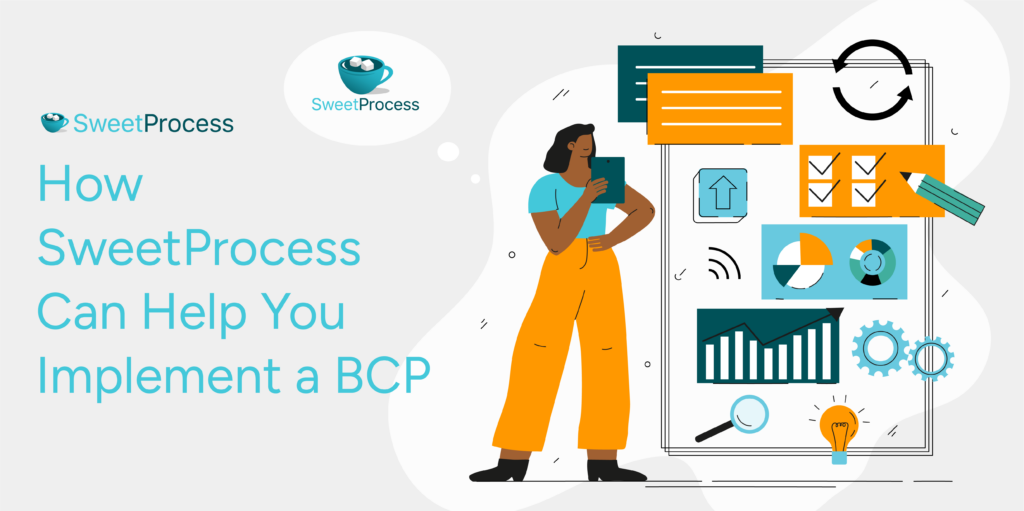
Processes are a big part of business continuity plans. In this section, we’ll discover how you can use SweetProcess to create processes for your business. Creating processes with SweetProcess is as easy as seven steps.
SweetProcess is designed to allow you to create connected assets. For instance, you can group processes into a database, complete with folder organization, and decide whether to share that with your team internally or with your customers as a customer-facing database.
You can also add team members to SweetProcess and assign each process to a team member. In the event of a disaster, activating your continuity plan is as simple as choosing a method, determining whose role or responsibility the task is, and clicking “Assign.”
Those are some ways you can use SweetProcess. You can try it out for free for 14 days.
But since creating the process is the first step, here’s how to use SweetProcess to create a process.
Step 1
The first step is to access your SweetProcess dashboard and locate the sidebar.
Once you get there, click the “+” symbol beside the “Processes” tab.
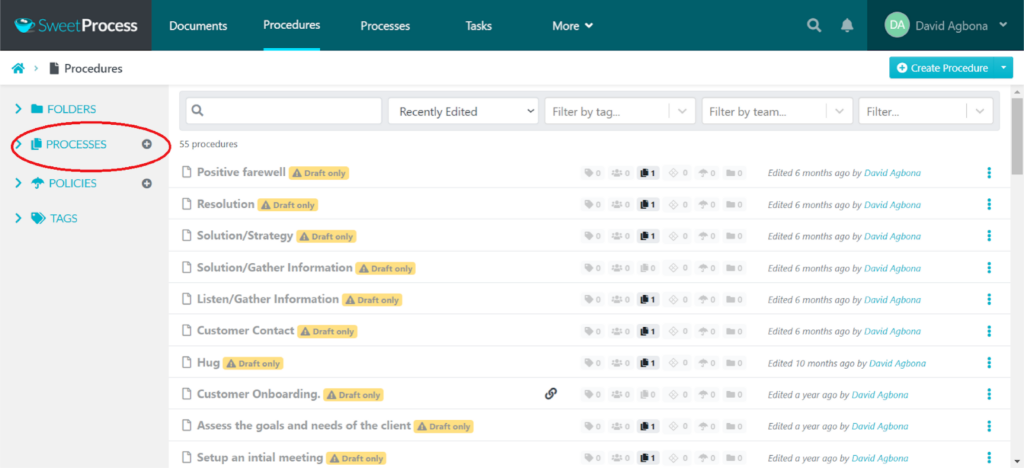
Step 2
A dialog box appears that allows you to name and title the process.

Step 3
Once you’ve created your process, the next thing to do is to list all the steps consecutively.
To do this, click “Add Step.”
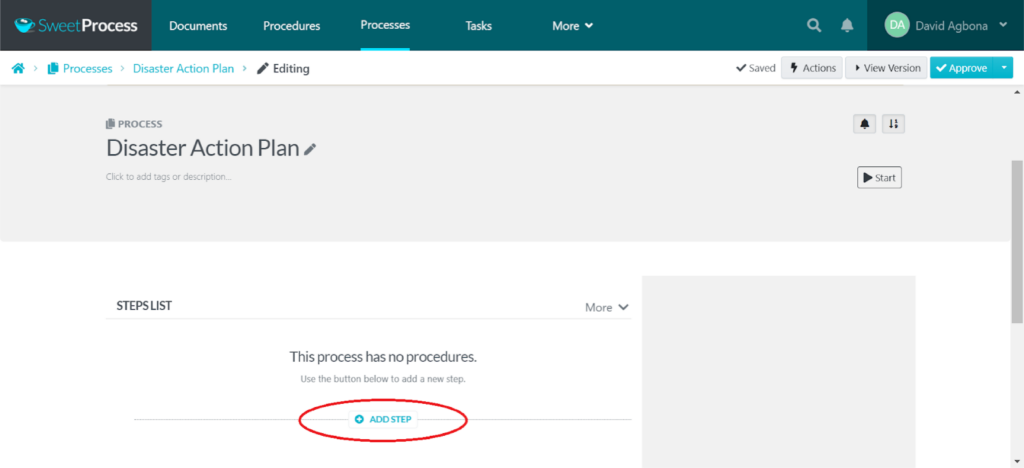
Step 4
Clicking “Add Step” drops down a dialog box containing three options. Click on “Procedure.”
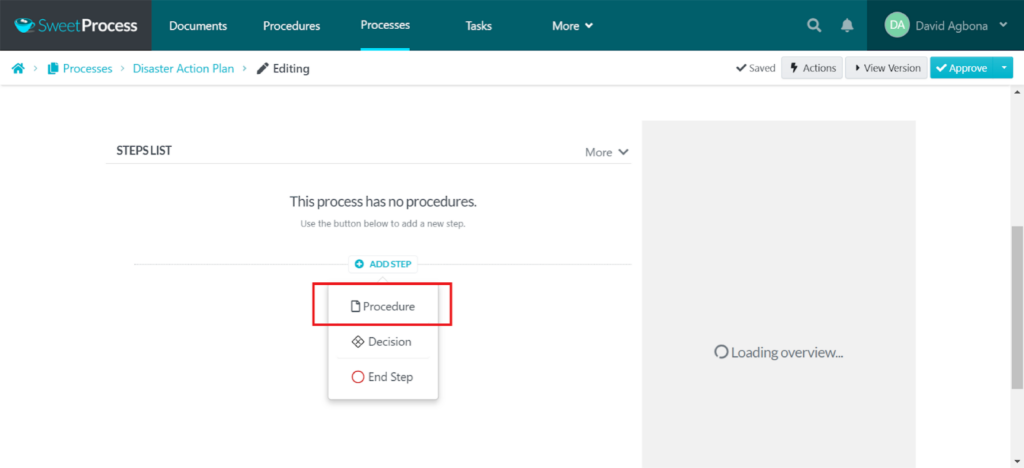
Step 5
Title the step accordingly.
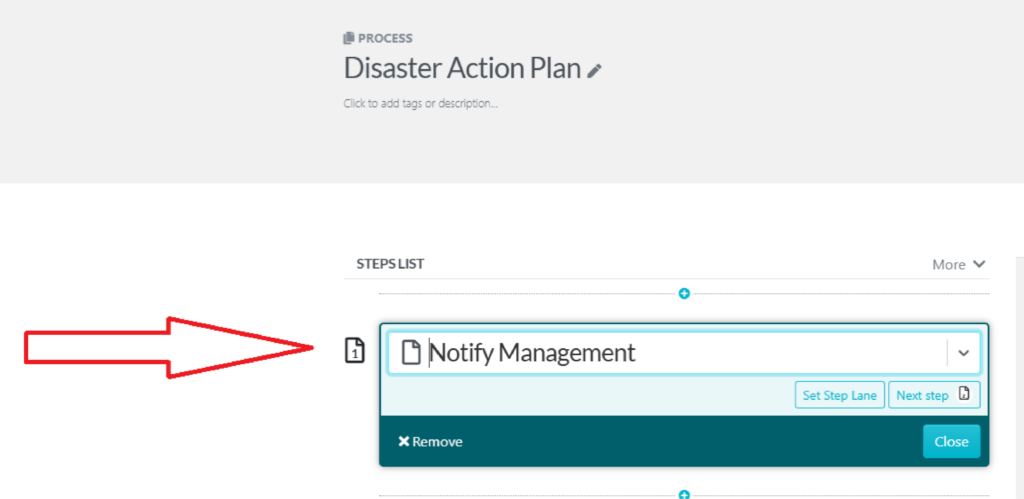
Step 6
Now, just repeat the same steps as many times as you need.
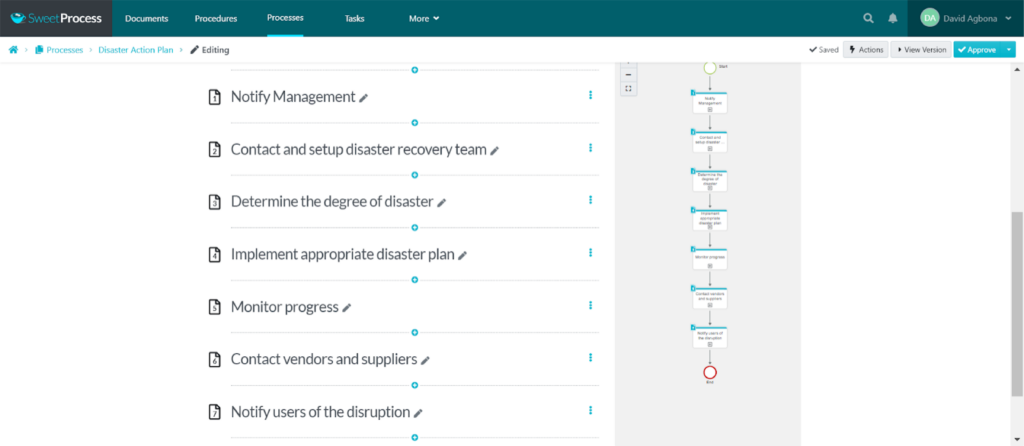
Step 7
Finally, approve the process so it goes live, and you can share it with your team.
In the “Approve” drop-down menu, choose an option that best fits your role in the team. If you’re the team lead, simply approve and notify. If you’re a collaborator, you can “Request Approval.”

How a Dental Clinic Used SweetProcess to Keep Operating Safely After COVID-19

The Dentist Off Main was a dental clinic already on the way to business excellence. Alex and Olesya were in charge of operations. They had been using the EOS business model (a six-component business model created by Gino Wickman) and managed to create a harmonious, people-oriented work environment for their employees.
Because processes are a key element of the EOS system, Alex and Olesya already used processes to systemize the business. However, the Word documents they used were hardly enough for their purposes.
So they sought the help of Adi, a business process consultant. Adi already had some success with SweetProcess with other clients, and she recommended the software to them. Midway into getting on board with SweetProcess, the pandemic hit, and the onboarding process had to be paused.
After the smoke cleared, they knew they couldn’t risk operating with their clunky processes because now, the health and well-being of their clients were at stake. They raced against time to implement SweetProcess, and the results were spectacular.
Before the pandemic, Olesya worked with an intern who was difficult to train. However, after implementing SweetProcess, Olesya reported much better results with the intern. Within a month, the same intern who struggled now integrated smoothly into the business and took on more responsibility than Olesya even thought possible.
Most importantly, they used SweetProcess to keep risk to a minimum because now, they could design fewer customer touchpoints to manage the risks of health hazards. The added benefit of this was that they were able to deliver comprehensive care quickly and efficiently, which created a much better customer experience for their clients.
It’s Not All Fun: Challenges of BCP Implementation
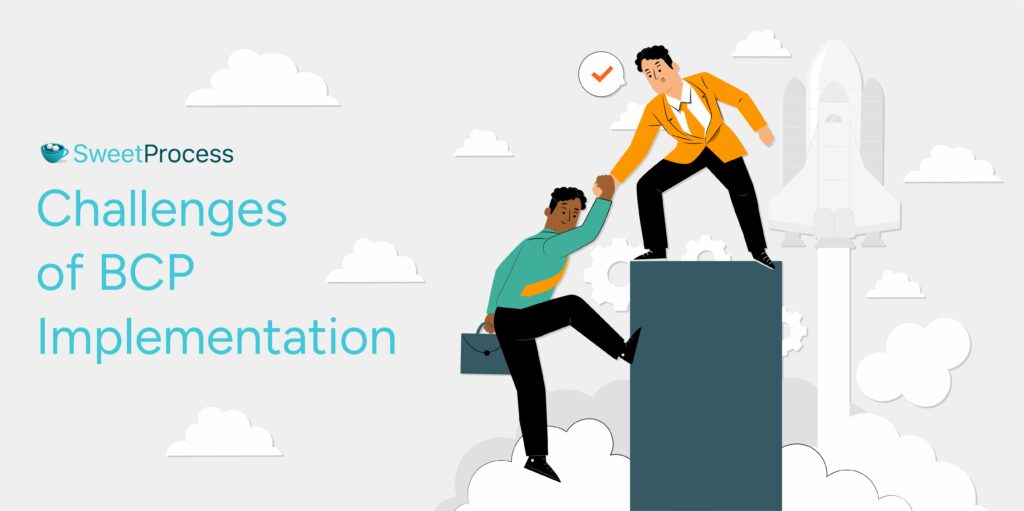
Although BCPs are beneficial in many ways, your strategy will not manifest from thin air. Planning, creating, and implementing a BCP strategy can cost time and money. Depending on how your business is set up, this may detract from your bottom line as your team members need to be involved with the process. Not only that, but they also have to become familiar with the material and ultimately test it out, as we’ll see in the following section.
Management isn’t exempt from this time scourge. They also have to supervise the creation of continuity assets, and using software for testing and simulation may also cost money.
Despite all the money and time spent creating BCPs, they aren’t perfect. Like all plans, they don’t typically account for every scenario. Even worse, implementing a continuity plan can become a burden because plans, if too heavily relied on, can be limiting because they cannot account for every possible scenario. If there is no flexibility in implementation, a resilience plan can quickly become a tool for chaos.
Another challenge is buy-in. If your team isn’t involved with the creation process, disasters could prove worse as the assets created could be misleading without the input of experience.
One solution could be to consider BCPs as a form of insurance or a way to protect your business. Although it’s costly to train your staff to get on board with a BCP, it’s easier to think of it as investing in your people. After all, your team is why you can be in and remain in business.
If you’re still on the fence, remember there’s no insurance for lost brand equity. If your customers leave because you’re unprepared for disaster, you may soon be out of business.
Validating Your Business Process Plans: Types of BCP Testing

Business continuity plans depend on people to execute. So, it’s important to validate your plan so you and your team can gain the confidence to handle disasters and crises when they arise.
There are many ways to validate your BCP. These include walkthroughs, tabletop exercises, simulation tests, and emergency drills to observe how your team will respond under stress.
BCP testing exposes all the gaps in your continuity plans and helps you to make them more efficient. Again, because people are the biggest component of executing a BCP, there will be a couple of interdependencies between departments. BCPs help you understand the relationship between multiple departments in your business and how to navigate the relationship between teams and coordinate efforts to ensure preparedness.
If you test regularly, you will ensure your continuity plans are updated. Up-to-date plans are more reliable. The following are ways to test your BCP.
Tabletop Exercises
Tabletop exercises can be thought of as a brainstorming session. During the exercise, team members and management review the business plan, looking for inconsistencies and inefficiencies.
Although the main reason for doing a tabletop exercise is to validate the BCP, an added benefit is the feeling of ownership and sense of belonging that such an exercise can give to your team members.
To keep this activity focused and productive, focus only on realistic situations your team may face. Go over the plan’s scope and objectives and try to refine them with your team’s input.
Plan Review
Where a tabletop exercise involves your employees, a plan review is an audit done by management. C-level executives, team leaders, and the business continuity team will go over an already existing plan and then decide what to omit, what to retain, or what to edit.
This is important because upper-level management is more aligned with the business’s vision and goals; thus, they can provide useful insights that your team may not have. If new managers are being onboarded, this can also serve as a sneak peek for the new trainees into the workings of your business.
Walk-Throughs/Simulation
Simulations mimic a real-life scenario and typically require a hands-on approach as opposed to a tabletop or a plan review.
The goal is to build the confidence of your team by giving them practice. It is better (advisable even) to validate your business continuity plan using the above methods before using this so you don’t discover inefficiencies mid-test. Although business continuity plans take time to create and then validate, doing them efficiently can save you time.
Just as with process improvement, you will ideally perform your simulation, record results, and then make improvements.
Business Continuity Plan Application: Real-World Impact
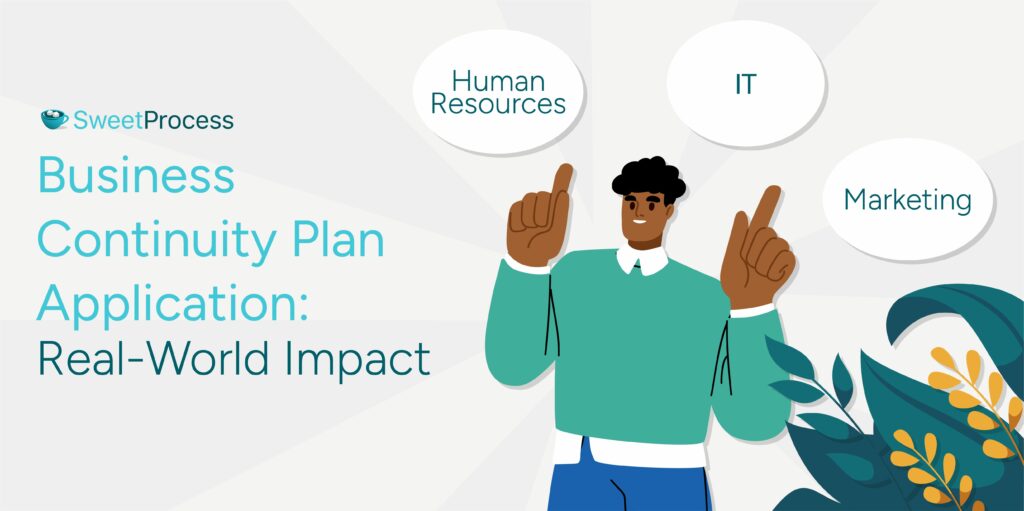
Now that you know how to validate your continuity plan, how do you apply it to your business? There are several scenarios in which continuity plans can be used.
Along with industry-specific scenarios, we’ll use some team-specific examples to jump-start your strategic thinking. These are the following ways a business continuity plan can benefit your business, as well as some real-world examples.
Human Resources
People are the foundation of any business. Both your customers and your team contribute immeasurably to the success of your business. In the case of service downtime, your team is the first to benefit from preparedness.
In times of crisis, fear and uncertainty are usually the prevalent sentiments. Your employees may be worried for their safety, the safety of their loved ones, and the safety of their jobs. But if you’re prepared, you can give them a sense of security. If they feel taken care of, they can bring their best to work.
Ireland’s healthcare system (HSE) was underprepared for cyber attacks. When a ransomware attack occurred in 2021, employee payment systems went offline, and payments for about 150,000 employees were delayed. Talk about an HR disaster.
IT
People are crucial to your success. But they need tools, and these days, many businesses operate digitally in one form or another. So technology is incredibly important.
If anything interferes with the smooth operation of your technology, you could lose money by the bucketfuls. As we discussed earlier, a business continuity plan in the context of IT is a disaster recovery plan. Make sure to have backups and hardware replacements in the case of downtime.
Cantey technology is a classic example of how a continuity plan can preserve normal operations. In 2013, lightning struck a building in North Carolina, causing a fire outbreak. Fires ravaged the offices of Cantey Technologies, destroying cables, computer hardware, and critical infrastructure.
However, their customers didn’t notice any change because the company’s leadership was prepared. They had moved their 200+ client servers to a remote data center where backups were held.
Marketing
If your business relies on public perception, PR disasters are a nightmare. What happens when a disgruntled influencer or customer makes a post that goes viral?
For businesses that thrive (and indeed survive) on positive branding, you must have plans in place to handle PR disasters. Because the marketing landscape is dynamic, you should also have plans in place to keep pace with the algorithms and their nuisance (pesky) updates.
Use email marketing to build a backup of customer contacts in the case of a failed social media strategy or a crippling update. Be ready to pivot to paid marketing if Google decides to cripple your organic channels with yet another update.
Hurricane Harvey was a brutal display of the destruction nature is capable of. The stormy winds and relentless rain left $125 billion worth of damage in its wake, and as usual, many small businesses did not survive. But Gaille Media was prepared.
Because they had backed up all their records and data, this marketing agency wasn’t affected by their evacuation. They were able to keep operating by going remote. In fact, their leadership decided to keep the team remote after the disaster because of reduced overhead, modeling how the world would adapt to work during the pandemic three years later.
SweetProcess, Your Partner in Agility
To stay long in business, you have to plan for longevity. A solid, tested BCP strategy is key to keeping the lights on during and after disruptions.
SweetProcess is a powerful suite of tools that allows you to plan, create, and visualize elements of your BCP strategy. With the ability to create processes and policies and generate flow charts, you can easily stay on top of your BCP strategy.
